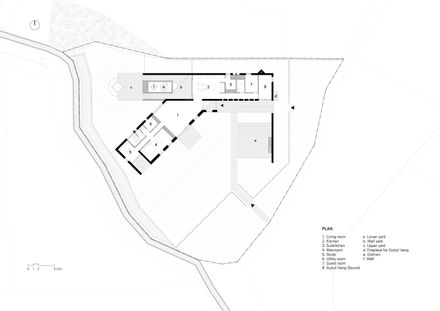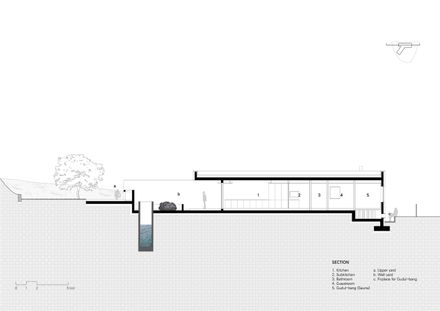Dolmenic House
ARCHITECTS
TURTLE Architects
ARCHITECTS
Choi Hyunsung, Choi Yiseob, Lee Changyul
CONSTRUCTION
Jungwon CID
PHOTOGRAPHS
Lee Gangseok
AREA
199 m²
YEAR
2022
LOCATION
Goseong-gun, South Korea
CATEGORY
Houses
Text description provided by architect.
TECTONIC ARCHITECTURE: Architecture, Starting from the site. Just as salmon must return to the place where they were born, humans have the disposition to return to the place where they were born. It is a slow inertia that spans about 90 years of life.
The client was born on this very site in Goseong, Gyeongsangnam-do, and spent his childhood here. The client worked in Seoul and lived here for the rest of his life, and after his parents passed away, he commissioned us to design a house to prepare for life after retirement.
Considering that the site has been handed down over eight generations, we focused on on-site analysis before the design. On the site, there was a Korean traditional wooden house where the client’s ancestors lived.
Through consultation with the client, we decided to disassemble the house, and use traditional building materials (such as wood, roof tiles, and foundation stones) for a new house. A unique element in this land is its old well and dolmen.
The well has existed since the client's ancestors were located on this site. And at that time, this village was the clan village of the Jeonju Choi family, so it was well-used by all family members. The client said the well was not to be filled recklessly and wanted to use it as a design element for a new house.
There is a dolmen next to the well. We don't know why, but it is said that there was a dolmen on this land even before the client was born. This rock, called ‘Jiseokmyo’ in Korea, is one of the representative tombs of the Bronze Age and is commonly called a dolmen. We decided to use both this well and dolmen as architectural elements.
Design Logics - Through consultation with the client, we worked on classifying what to eliminate and what to maintain on the site. After demolishing the site except for the well, dolmen, trees, and the site of a traditional house, the terraced form of this site originally stands out.
It was decided to create a yard of various heights without damaging the appearance of the site. In particular, the well has been set as a key topic of this project.
Therefore, from the beginning of the design, the axis of the drawing and the work point of construction were also worked based on this well. On the north side of the site, many recently built flat houses are visible.
On the other hand, reservoirs and mountains spread out on the south side of the site. Therefore, when planning the arrangement, we planned to open the building as much as possible in the south direction. Bent House - The site is lowlily surrounded by Bonghwa Mountain.
We imagined a low and long stretch of the house to match the mountain. The house naturally opens toward nature in the south, bending along the shape of the site.
In particular, the inflection point of the house is planned based on the zelkova tree that the client's ancestors planted, so you can see this tree from any window inside the house. 3 Yards - Various heights of yards were planned by using the terraced form of the existing site.
It was named according to the characteristics of the yard and closely connected to the house. In the case of the lower yard built on the site of the old traditional house, it was planned as a space where many people can gather.
Covering and noise from the outside were considered through the floor 60cm lower than the ground level and the 2m high wall.
And it was planned to be large enough to serve the memorial ceremony of this family. The good yard, where the well and the dolmen are located, is an intermediate area connecting the kitchen and the upper yard and focuses on the view, not a function.
It was intended to make the kitchen feel like an art gallery by allowing the well and dolmen to be seen through the window and the exposed concrete wall of 15m length from the inside to the outside.
After passing through the good yard, you will find the upper yard, which is 1m higher than the 1st-floor level. There is a Lilac tree, and the yard surrounded by a 2m high slope, functions as a private area.
Open And Close - When planning the arrangement, it was considered to open as much as possible with the nature of the south, closing the direction of the village in the north.
Therefore, the window plan also had a high-side window on the north side so that the mountain peaks and the sky could be seen, and the south side could be opened as much as possible through the fully opened window. The windows in the south are designed to be fully opened or closed as necessary through louver doors.
Through these doors, the amount of sunlight can be adjusted. In response to the client's request that there are many visiting guests, it was planned to be divided into a space used by the client and a space used by customers, by the inflection point of the house.
A living room and a kitchen are placed between the client's space and the guest's space, a sliding door is placed between each space to separate the space as necessary, and unused spaces are closed to increase energy efficiency.
Traditional Heating System - The space specially requested by the client is a sauna. Based on the context that this place has been handed down from generation to generation, it was agreed to create a sauna as a traditional "gudul-bang".
Gudul is a Korean traditional heating system, a room paved with flat stones and heated by floor heating below it. This is the same principle as the hypocaust, which was mainly used for thermae in ancient Greek-Roman culture.
However, in consideration that this is a modern house, through consultation with experts, it was constructed in detail in which the traditional heating system and modern heating system coexist.


























